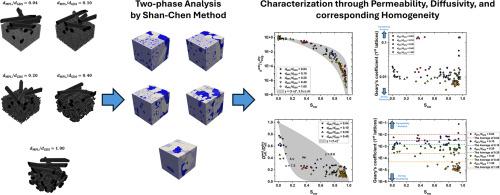用Shan-Chen法研究纤维与颗粒直径比对气体扩散层输运特性的影响
IF 5.8
2区 工程技术
Q1 ENGINEERING, MECHANICAL
International Journal of Heat and Mass Transfer
Pub Date : 2025-09-23
DOI:10.1016/j.ijheatmasstransfer.2025.127839
引用次数: 0
摘要
本研究表征了聚合物电解质燃料电池(PEFC)中具有纤维状和颗粒状结构的双孔层,类似于气体扩散衬底(GDS)和微孔层(MPL)。纤维(GDS)和颗粒(MPL)直径之间的特征长度之比从0.04到1.00不等,创建了150个模型,用于本研究的分析。纤维直径固定为7.00µm,产生的晶粒直径为0.31 ~ 7.00µm。利用基于晶格玻尔兹曼方程的Shan-Chen方法,研究了干燥和饱和条件下的有效传导和扩散系数、绝对渗透率、相应的温度、浓度和流体密度分布的均匀性。结果表明,较小的直径比(0.04和0.10)导致较低饱和度(Snw<0.7)下渗透率和扩散系数降低。然而,无论直径比如何,这些值在高饱和度时收敛。与最粗结构(直径比为1.00)相比,由于较细的孔隙网络和较低的疏水性,在高度饱和条件下(Snw>0.9)的均匀性指数(Geary’s系数)显著提高,渗透率达到22.2倍,扩散系数从接近0(强聚类)提高到0.079倍。这些发现表明,在有催化剂的反应位点附近使用更细的MPL网络和在流道附近使用更粗的MPL网络可以提高PEFC的性能,为设计具有梯度孔或孔隙结构的气体扩散层提供了理论基础。本文章由计算机程序翻译,如有差异,请以英文原文为准。

Effects of diameter ratio between fibers and grains for gas diffusion layer on transport properties via the Shan-Chen method
This study characterizes dual porous layers with fibrous and granular structures with hydrophobic agents, resembling gas diffusion substrate (GDS) and microporous layer (MPL) in polymer electrolyte fuel cell (PEFC). The ratio of characteristic lengths between fiber (GDS) and grain (MPL) diameters was varied from 0.04 to 1.00, creating 150 models that were analyzed in this study. The fiber diameter was fixed at 7.00 µm, yielding grain diameters from 0.31 to 7.00 µm. Effective conduction and diffusion coefficients, absolute permeability, corresponding homogeneity of temperature, concentration, and fluid density distribution were examined in both dry and saturated conditions using the Shan-Chen method based on the lattice Boltzmann equation. Results show that smaller diameter ratios (0.04 and 0.10) lead to decreased permeability and diffusivity at lower saturation (. However, these values converge at higher saturation regardless of the diameter ratio. Due to the fine pore network and hydrophobicity at lower diameter ratios, the homogeneity index (Geary’s coefficient) at highly saturated conditions ( was boosted significantly—up to 22.2-fold for permeability and 0.079 from almost 0 (strong clustering) for diffusivity—compared to the coarsest structure (diameter ratio of 1.00). These findings indicate that employing a finer MPL network near reaction sites with catalyst and a coarser network near flow channels may enhance PEFC performance, offering a theoretical basis for designing gas diffusion layers with graded pore or porosity structures.
求助全文
通过发布文献求助,成功后即可免费获取论文全文。
去求助
来源期刊
CiteScore
10.30
自引率
13.50%
发文量
1319
审稿时长
41 days
期刊介绍:
International Journal of Heat and Mass Transfer is the vehicle for the exchange of basic ideas in heat and mass transfer between research workers and engineers throughout the world. It focuses on both analytical and experimental research, with an emphasis on contributions which increase the basic understanding of transfer processes and their application to engineering problems.
Topics include:
-New methods of measuring and/or correlating transport-property data
-Energy engineering
-Environmental applications of heat and/or mass transfer

 求助内容:
求助内容: 应助结果提醒方式:
应助结果提醒方式:


